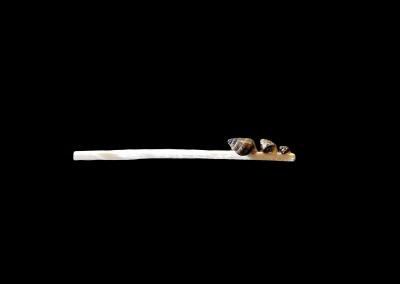
Credit: Kenneth Hayes and Norine Yeung
GAINESVILLE, Fla. — Scientists have described a new native Hawaiian land snail species, sounding a rare, hopeful note in a story rife with extinction.
Pacific island land snails are among the world’s most imperiled wildlife, with more recorded extinctions since 1600 than any other group of animals. Hawaii’s once-teeming land snail scene of more than 750 species has shrunk by more than half, ravaged by habitat loss and invasive species such as rats, Jackson’s chameleons and the carnivorous rosy wolf snail.
Auriculella gagneorum, a small candy-striped snail from Oahu’s Waianae Mountains, represents the first new species of a living Hawaiian land snail described in 60 years. The species “brings that little glimmer of hope that this isn’t all a depressing story,” said the study’s lead author Norine Yeung, malacology curator at the Bishop Museum.
A team of researchers found A. gagneorum during a large-scale, decade-long survey of land snails that spanned 1,000 sites throughout the Hawaiian Islands. They then used the Bishop Museum’s collection of land snails to match individuals collected during the survey to unidentified specimens from the 1940s.
“This is a happy story where we discovered a snail that is still around,” Yeung said. “There are so many things in our collection that we can no longer find in the wild. But in this snail’s case, we can finally put a name to it and describe it, which is huge for the conservation of this species.”
The tree-dwelling snail shows pronounced variation in coloring, from burnished tiger’s-eye patterning to dramatic sable and white stripes. At less than two-tenths of an inch long, “you might be able to fit a dozen on your fingernail,” said study co-author John Slapcinsky, collection manager of invertebrate zoology at the Florida Museum of Natural History.
Land snails play a crucial role as decomposers and fungivores in Hawaii’s ecosystems, essentially “our first recyclers,” Yeung said.
The researchers deposited a selection of A. gagneorum snails in Hawaii’s captive breeding program, with the goal of increasing their numbers and returning them to the wild. They named the species in honor of the late Hawaiian naturalists Betsy and Wayne Gagne, who were “powerhouses for conservation,” Yeung said. “They cared about the whole ecosystem, whether it was a tiny little bug or plants or one of Hawaii’s charismatic, beautiful forest birds.”
The team’s survey also produced new records of three snail species last documented in the 1950s and others feared extinct, as well as nearly 30 new species. The researchers failed to find two species, A. auricula and A. minuta, whose populations may have died out.
But while the status of Hawaii’s land snails is dire, it’s too early to despair, said Slapcinsky, who gamely struggled through skin-ripping raspberry thickets and nearly slid off a cliff while sieving for snails.
“People used to think it wasn’t even worth studying Hawaiian land snails because they were all extinct. Now we know they’re not,” he said. “If we work at it, there’s still a chance to do something about it. That’s why it’s important to be out there surveying, finding the remaining populations of these species.”
Yeung said previous reports estimated that 90% of Hawaii’s land snails were extinct, but the team’s survey shows that about 300 species still survive in remote, isolated parts of the Hawaiian Islands.
“The challenge now is trying to identify all of these because we have lost a lot of experts, and a lot of these snails are super tiny,” she said. “If you’re not a trained malacologist, the small brown snails might all look the same to you. But when you take a closer look at their shells, bodies and genetics, these little things are all different and can be tied to different valleys and ridges. When one species turns out to be three, we can run into problems with conservation.”
The researchers used a combination of physical characteristics and DNA to describe the new species. While its shell size and shape mimic A. perpusilla snails from the Koolau Range on east Oahu, molecular evidence shows A. gagneorum is more closely related to A. tenella, a slender, high-spired snail from the Waianae Range in the west.
A. gagneorum belongs to a long-overlooked group of snails known as Auriculellinae. The majority of attention and conservation efforts have focused on the larger, more colorful snails in the subfamily Achatinellinae, Lonesome George, the last known snail of its species, being the most famous example. While an entire genus of Achatinellinae is listed under the Endangered Species Act, the smaller, less obvious snails in the subfamily Auriculellinae remain understudied and unprotected, Slapcinsky said.
“We’re not bemoaning that Achatinellinae are getting attention. They do need help,” he said. “What we’re concerned about is that these other things are getting ignored.”
Meanwhile, the team pushes forward in its analysis of a decade’s worth of data and many new species descriptions. Afterwards, the researchers can turn their attention to the evolution and ecology of Hawaii’s land snails, traditionally considered by native Hawaiians as important symbols and good omens that represent change, romance and song.
“The diversity is amazing, the species are amazing, and there are so many evolutionary stories you could tell,” Yeung said, describing malacology as a “wide-open frontier.”
“But first we have to identify these snails. If you ask about their habitat and life history, it’s like, I wish I could tell you. Right now, I can just tell you this is a different species and put a name on it. It’s hard work, but it’s so gratifying.”
###
The researchers published their findings in ZooKeys.
Ellen Strong of the Smithsonian’s National Museum of Natural History and the Bishop Museum’s Jaynee Kim and Kenneth Hayes also co-authored the study.
Media Contact
Natalie van Hoose
[email protected]
Original Source
https:/
Related Journal Article
http://dx.




